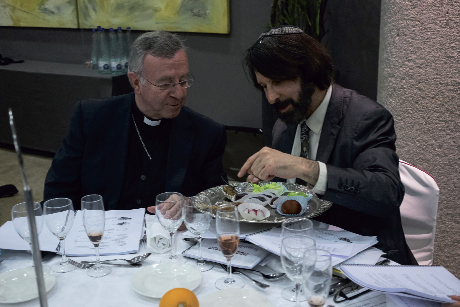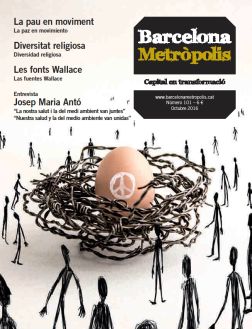The Grup de Treball Estable de Religions [Religions Stable Work Group] is an initiative that arose from the Universal Forum of Cultures in 2004, and brings together leaders from the five religious traditions with the greatest followings in Catalonia.

Stephen Berkowitz, rabbi of the Bet Shalom community, explains the Jewish tradition of Passover to Sebastià Taltavull, auxiliary bishop of Barcelona, during a commemorative ceremony organised in a hotel on 22 April 2016.
Photo: Arianna Giménez
On Christmas Eve in 1990, the then Archbishop of Barcelona, Ricard Maria Carles, laid the first stone of the Abraham Centre. The 1992 Olympic Games were on the horizon and the Olympic village needed a multi-religious space for the thousands of athletes (of different faiths) that the city would host. From that multi-religious centre proposal was distilled the need to structure interreligious dialogue in the city.
The Grup de Treball Estable de Religions (GTER, Standing Working Group on Religions) was born out during the Parliament of the World’s Religions held during the 2004 Universal Forum of Cultures. Joan Hernàndez is the director of GTER, a group formed by leaders of the Catholic Church and of the Protestant, Orthodox, Muslim and Jewish communities. Whenever a workshop is organised, GTER also invites Mormons, Sikhs, Buddhists and Baha’is. “We have the five religious traditions that have the longest history and are most established in Catalonia. Coordinating them is no mean feat, and if we were to incorporate other faiths that have different goals and are less established, it would be much more difficult.” The Group is extended at least twice a year, forming the Intrareligious-GTER Council, when there are invited all religions in Barcelona.
This great diversity of communities within each religion sometimes makes dialogue difficult within each faith, known as intrareligious dialogue, which even Hernàndez admits “is more difficult than interreligious dialogue”. He says that the most important thing “is not that they argue, but what is taken away from the disputes”, and recalls that “relations were worse in the 1990s, when some judicial proceedings were launched among them. Everything is calmer now.”
Wadud and his Sufi community only have a close relationship with two other Muslim oratories in the city, but they do not consider this to be a problem “because we are all brothers”. He does see a problem that, in his opinion, is fragmenting the Muslim community in Barcelona, in the influence of Saudi Arabia on some Islamic communities: “That country is subsidising books, oratories and visits by imams, and it pays for pilgrimages; its message has caught on here. It has become the indoctrinator of the Islamic world in the West and sends people into communities with a discourse that is backward, stubborn, reactionary, radical, extremist… terrible.”
For Griera, the GTER model is “that of religious leaders, with a very important role for the Catholic Church”. Another model for Griera is the UNESCO Association for Interreligious Dialogue (AUDIR, Asociación Unesco para el Diálogo Interreligioso), albeit a “more basic” model, she says.
Francesc Torradeflot is the director of AUDIR, which works for religious freedom for communities and freedom of conscience for atheists and agnostics: “It’s more than interreligious dialogue; we are seeking inter-denominationalism”. He warns that the reduction in the aid that the administration allocates to the association puts its planned activities at risk. In addition, he says that the religious community members have other priorities: “They’re worried about the community itself, their families, their work… Dialogue comes second and is used more for resolution than for prevention.”
Once the Olympic Games were over, the Abraham Centre became the parish of the Prophet Abraham, i.e. a Catholic church in the new Vila Olímpica neighbourhood. The idea of setting up a new multi-religious space was put back on the table years later. “We conducted a survey and even the most precarious communities were against it, because they wanted their own space”, explains Cristina Monteys, OAR director. “This demand is understandable, because a place of worship is also the communities’ home.” The idea was shelved.
Seen from the air, the outline of the Prophet Abraham parish is in the shape of a fish, the sign used in the age of the catacombs so that Christians could safely recognise one another. Centuries later the fish became an ecumenical symbol of union between all branches of Christianity. But only of Christianity.



